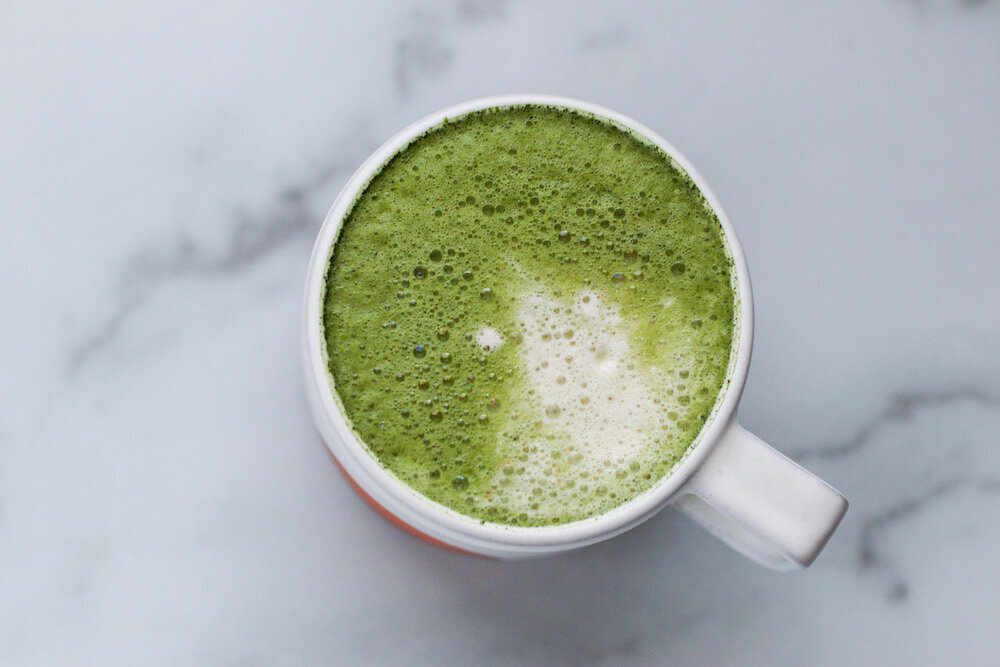How to Make the Perfect Matcha Latte at Home
I’ve been drinking a lot more matcha than coffee lately for a few reasons.
With all our IVF treatments and pregnancy, I’ve been trying to cut down on caffeine.
I truly LOVE the way it makes me feel — energized and focused without the caffeine crash.
And after about a year tinkering with my house recipe, I’ve finally perfected it.
But before we get to the delicious end product, I’m answering some of your matcha Qs + sharing my go-to resources for easily making it at home yourself.
Matcha Tips + FAQ
What is matcha?
Matcha is a powdered tea primarily grown in Japan made from finely ground green tea leaves. They’re usually from a first harvest and more delicate than the traditional green tea you’ve had. Rather than steeping the leaves in water, you drink them whole in the ground form.
Does Matcha have any Health Benefits?
Yes! Because you’re drinking the leaves whole, you get a saturated dose of the amazing health benefits matcha has to offer:
Clear, focused energy thanks to lower caffeine combined with L-theanine, a compound that stimulates alpha brain waves for an alert, but calm effect. I.e: exactly how I want to spend my mornings.
High amounts of antioxidants such as EGCG to boost immune function, reduce inflammation, and heal free radical damage. This compound has also been shown to boost metabolism.
Chlorophyll which removes heavy metals _ other toxins from the body. Think of it as adding greens powder to your morning AND getting the feel good effects from the caffeine x L-theanine combo.
Less acidity than coffee which means fewer stomach upsets if that’s typically an issue for you.
How do I source the right Matcha?
So this is KEY as poor quality matcha not only tastes bitter, but you also run the risk of consuming heavy metals and toxins. Which is why I always look for single-origin and/or organic “ceremonial grade” matcha.
I’ve tried A LOT of matcha, and right now my favorite brands are Matchaful (Kiwami), Cap Beauty, and Pique Tea.
Side note: Both CAP Beauty and Pique have individual packets of matcha which are amazing for travel.
What do I need to make Matcha at home?
Traditionally, matcha is made in a wide bowl using a bamboo whisk, but I find making it with a hand whisk or in a blender is much easier and gets it frothier too.
Check out my shop page for my favorite hand whisk and milk frother as well as some fun elixir add-ins like coconut milk powder and adaptogens.
Any other tips?
Don’t add straight boiling water. It can burn the delicate leaves and make even the best matcha taste bitter. It’s best to set boiling water to the side for at least 5-minutes or use an electric tea kettle with an adjustable temperature setting. You’re looking for roughly 180 degrees F.
All about the froth.
Making matcha is actually super easy. 1/2-1 tsp. powder blended or whisked with 4 ounces off boil water and 6 ounces of warmed non-dairy milk is my go-to basic version.
My Morning Matcha
Makes one 12-ounce beverage
Ingredients:
1 tsp. ceremonial grade matcha tea
4-6 ounces off-boil water (roughly 180 degrees)
6 ounces frothed/warmed non-dairy milk of choice
splash vanilla extract and/or dash cinnamon
honey or monkfruit sweetener, optional to tasteOptional add-ins:
1 tsp. coconut cream powder
1 scoop collagen peptides
1/2-1 tsp. adaptogens of choice (maca, ashwaghanda, reishi, mucuna)
Directions:
OPTION 1:
Add matcha, coconut creamer, and collagen to your mug. If matcha is clumpy, use a small seive or the back of a spoon to break it up.
Bring water to boil and set aside for 5-minutes to cool or set electric tea kettle to 180 degrees.
Warm milk of choice with vanilla + cinnamon and froth. I use this Breville frother for a one-step process. It’s also great for making coffee lattes.
Add off-boil water to mug with matcha and whisk. Top with frothed almond milk for the most “latte-like” experience.
OPTION 2:
Warm water and milk gently in a sauce pan. Add to blender along with matcha, collagen, etc. Blend for 20-30 seconds and enjoy!
NoteS: If matcha seems a bit bitter to you, start with 1/2 teaspoon and work your way up to the full 1 teaspoon. If you’re out of nut milk, I also make a version using 10 ounces of water and a spoonful of coconut butter for creaminess.





